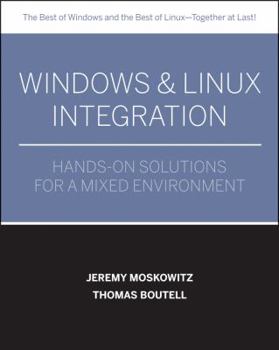Windows & Linux Integration
* Don't Just Cope With Your Mixed-Environment Problems-Solve Them * Maximize Productivity and Lower Costs by Strategically Combining the Strengths of Linux and Windows * Leverage Windows Resources from Linux, and Linux Resources from Windows * Meet All Your Remote and Terminal Connection Challenges with the Right Solutions WHY NOT HAVE THE BEST OF BOTH WORLDS? For all those who talk of a war between Windows and Linux, there are others-like yourself-who...
Format:Paperback
Language:English
ISBN:0782144284
ISBN13:9780782144284
Release Date:September 2005
Publisher:John Wiley & Sons
Length:539 Pages
Weight:1.90 lbs.
Dimensions:1.2" x 7.2" x 9.5"
Customer Reviews
5 ratings
Simply Awesome
Published by Thriftbooks.com User , 17 years ago
This book is awesome. Most books waste too much print giving you all the theories, wherefores, why, and very little step-by-step how-to. This book gives you all the how-to and enough theory to go with it to make it understandable and usable. I just used it to do an integration with a Windows 2003 R2 network with IBM ClearCase 7 servers running on RH Linux 4 and other RH clients. I couldn't have done it without this book and I have several others on the subject but from a Windows point-of-view. Be sure to visit the author's web page for the 2003 R2 updated info and other minor corrections and even downloadable scripts that are in some of the exercises. It saves typing.
Simply unbeatable
Published by Thriftbooks.com User , 18 years ago
This is an amazing book. It takes you though all the various permutations of Windows and Linux interoprerability. It pulls no punches on the good and bad points of each system. The fact that Samba/Linux and/or Windows can operate in many different contexts in a network is assumed, and each scenario is covered in great detail. The many and varied authentication techniques are the focus of the book (as they're by far the most complex pieces, and the lynchpin for any integration), but file and print sharing gets covered, as does IIS vs. Apache, ASPs, and so on. This is a book written by people who've had to learn their lessons the hard way. They do what IT professionals need to do (integration to make "things" work) and they mention the things professionals need to know (the corner cases and exceptions to the rules). Brilliant.
Amazing!!!!
Published by Thriftbooks.com User , 18 years ago
Its simply gr8! I am still reading the book, its very helpful for those who want to implement windows+linux environment.
Best Windows\Linux integration book yet
Published by Thriftbooks.com User , 18 years ago
I've been through a lot of books on using Linux and using Windows, but they come up empty when it comes to integrating the two environments. I've also read books on the individual components used in this book, but when I get to the sections on integration I run into theory and not practice. This book covers practice with just the right amount of theory so you know what you are doing. It has step by step instructions that lead you through to a working solution. If you want to be able to deploy both Windows and Linux in a business environment, this is the first book you should buy. Top notch.
Incredibly Amazing Rare Gem
Published by Thriftbooks.com User , 19 years ago
I seldom come across books that are not only very comprehensive but are very cutting edge up to date as well. What I like about the style is that they assume that you are knowledgeable and resourceful, and thus not padded with the concept theory of [insert technology here]. Yet, there's enough strategically placed summaries of technologies where needed, for example, PAM and NSS overview before delving into configuration of them. I found this approach very refreshing. For interoperability for authentication and single-sign-on solutions specifically, this book covers both NIS and LDAP/Kerberos (Active Directory) solutions. It has information and solutions for both directions, i.e. windows to linux and linux to windows. A lot of coverage on windbind magic, but also some stuff about other solutions like MS SFU, PADL's NSS and PAM modules and some notes on Vintela and Centrify. These sections are really good, but I still had some questions (that I wish were spelled out or expanded upon), such as: Does winbind need PDC or can it directly hook into Active Directory w/o being in mixed mode? Other topics include file/print sharing, e-mail integration (postfix and exchange), application compatibility, network interoperability (like VPN), and web interoperabiity including stuff on .Net and Mono project. All of those chapters are really well developed, with possible exception of Chapter 9: Windows and Linux Network Interoperability. For this particular chapter, I wish there could have been coverage of (1) OpenVPN, which has nice GUI application on Windows, (2) IPSec transport mode using KAME/racoon and/or OpenSWAN with MS IPSec security policies, and (3) IPSec tunnel mode with L2TP. Another quick thing to mention is that they have a quick chapter to ease you into Linux using Fedora Core and Webmin, and use webmin throughout the book. I thought this was a great approach, as it'll allow you to delve deeper into the technologies when you have the opportunity, but yet keep it simple so that you can get stuff going immediately. (( Slightly off topic, one freeware tool came out just after this book came out is Likewise open agent, which might also help ease into Linux administration as well )). In conclusion, this is a treasure trove of information. If you have any need to use both Linux and Windows environments, I wouldn't pass up this book.





